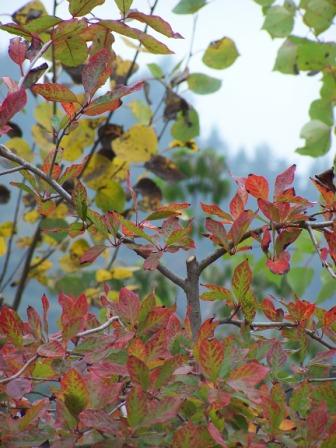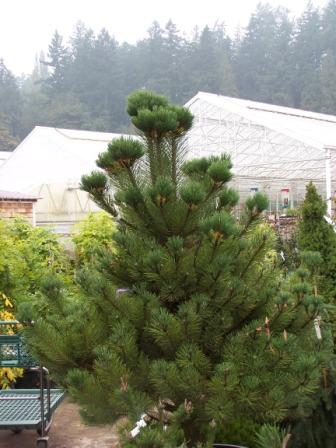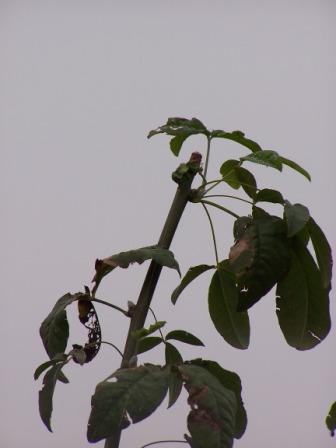About a year ago I posted my thoughts about the nursery production practice of heading young trees (“whips”) to stimulate lateral branching or columnar form or whatever. (You can find this original column here.) A healthy discussion ensued, much of which revolved around the need for appropriate follow-up pruning to ensure the development of a stable crown structure of headed trees.

Fast forward to last month, where a column I wrote for NPM (Nursery Production and Management) magazine hit the web. And then the fan.
I made some people very unhappy with this article. I had a lengthy and productive conversation with one such person last week, during which we agreed on many things, including (1) trees that are headed develop multiple leaders; (2) multiple leaders, however they’re created, need to be thinned to one central leader; and (3) uncontrolled multiple leaders can create hazardous conditions. The bottom line, from a nursery production perspective, is that headed trees require regular pruning to create and maintain natural, structurally sound crowns.

And here’s my problem: how many homeowners are going to perform this regular pruning? Furthermore, how many homeowners KNOW how to perform corrective pruning? We all know that number is going to be abysmally small. Even for those situations where competent arborists could do this regular pruning, how many communities budget for this activity?
More troubling for me as a scientist is the lack of peer-reviewed scientific papers on this practice. Though there are numerous papers documenting the effects of pruning, I can’t find any that specifically look at the long-term effect of heading trees during nursery production. You’ve heard all of us GP’s say it before – unless you can show us the data in a published and peer-reviewed format, we can’t regard anecdotes as anything but.

The nursery industry has invested a lot of time and money in a practice that leads to problems for which no one will claim responsibility. Production nurseries wash their hands of the issue once the trees leave their facility. Many retail nurseries don’t perform the necessary follow up pruning while the trees are in their care (do any retail nurseries do this? Are they aware of the problem?). Homeowners don’t receive information or training on how or why to perform corrective pruning.
What I’d really like to see the nursery production industry focus on is consumer education. The metamorphosis of a sapling into a maturing tree is a wondrous thing. Rather than interfere with the process, we need to cultivate patience as well as a respect for tree physiology.
Also how many homeowners know that pruning is needed?
Linda,
The real matter is how it looks in the pot for retail sales, not how it will actually grow-out in the ground. Trees with branches, even 5 gallon headed=whips with inappropriate branching, sell better than sturdy young whips without branching. I can do m
620
y best to educate our customers why the whip is a better choice, but they will usually go for the bushy-tree looking plant even though the branches are too low and tangled for optimal growth. For the few weird tree crops we produce ourselves we can control pruning and have a healthy well-formed product, but even with buying from excellent wholesale growers, the product that comes in is grown to meet the expectations of the market, not the science of tree growth. We do our best to prune and have great product, but most customers are going to buy what fits the image of what it should be, not what it will be in decade or so. Tree crops are pruned for psychological marketing reasons, not for science based crop management.
Oh, I know, Hap. You’re absolutely right. But whenever I bring that up, proponents deny that’s the main reason they do it. Again, it’s the consumer education piece that really needs to be developed, not these artificial and high maintenance production practices.
The market will change almost immediately after consumer’s demands change. Educating the consumer is not as easy as snapping your fingers – though with a career in extension, you understand. Consumers have to hear it over and over from various sources before changing their minds. In the meantime, retailers and wholesalers either sell pruned plants and wait for the conventional wisdom to change or s
19e0
tick to their guns, sell way, WAY fewer pants (unpruned whips), and have the right to say “I told you so” years later when people start understanding the value of the unpruned plant. It’s enormously difficult to turn away sales in that interim. Trying to teach people who don’t want taught is hard and expensive and overwhelming. Thank you Cooperative Extension for laying the groundwork for industry. Your hard work gives us something to point to when consumers balk.
Grr! The next tree I grow is going to be from seed.
I’m also trying to educate folks on this practice. See my piece on this topic and listen to my podcast.
http://www.sky-bolt.com/garden/#topping
Hmmm, I have a tree that I inadvertently headed. It is Prunus serotina that had been cut down but somehow quickly grew into a tree before I knew it. It has three main trunks–should I just take it down before a storm takes one if its trunks off? It snuck up on me, so now I feel bad chopping down a tree.
Val, you could just prune out two of the trunks, unless it would look even worse that way. Depending on the branch angles, you might be able to get away with just taking out one trunk. If you want to send me a photo (lindacs@wsu.edu) I can give my two cents’ worth.
Are there problems in current wholesale nursery production practices? Certainly…
Are retailers aware of these problems? Well, yes we are. Many of us actually consider ourselves to be professionals, actively engaged in our state associations and certification programs, educating the public through presentations to garden clubs, Master Gardener training sessions, even the occasional cable television appearance….
Do we do anything at all to address these problems? Yes, we do. Please see the article “Bad, bad trees” in this Kansas Nursery and Landscape Association newsletter: http://kansasnla.org/Newsletter%20June08.pdf
Hap was right on – pretty sells in this business. And a properly headed back tree looks real pretty – nice and full (altho nearly all those side branches will be removed on down the road as the tree grows and they get in the way of a lawnmower).
Notice I said “properly headed”. Leader removed, side lateral taped up each year. When that tree hits the retail lot, there is no further pruning of the leader. In general, the consumer need not continue to prune that tree, other than minor removal of crossing branches, or a vigorous competing side branch – the kind of growth that can happen in young trees – and which has nothing at all to do with the nursery production pruning practices…
The industry is going through a contraction during the current economic downturn. Growers who ship stubbed trees as Linda pictured aren’t going to be able to stay in business – I certainly don’t deal with them.
Finally, I’d like to point out that consumers will get what they pay for. If people want to buy their trees at a hardware store – well, they are often getting the kind of stock that upsets all of us in the industry. Supporting your local independent garden center and nursery is at least some assurance of receiving a healthy, vigorous, and properly grown tree that will live for decades….
Brian, I wish what you said was true all over the country. The trees I pictured in this and my other posting are from two of the largest, best known, and most popular retail nurseries in the Puget Sound region – they are not hardware stores. The producers are big names as well. That’s what’s so frustrating – there are few good choices for consumers in our neck of the woods.
Ok, a multiple leader trees can be a hazard, but quantify that hazard with some statistics if you can.
Alex Shigo began what has become almost a religious opposition to heading trees. I’ve always thought this objection was overblown- I live in a part of the country where an early snow or an ice storm can decapitate thousands of trees in a few hours.
The resulting growth often creates multiple leaders that sometimes snap off but it is extremely rare for someone to be hurt- probably because it usually occurs during storms.
I agree that trees trained for failure right out of the nursery are unfortunate but I’ve seen how the public prefers these full looking trees over ones more structurally sound. I don’t think they represent enough of a hazard that you’ll be able to change production methods as things stand.
What surprises me is how very few arborists go through a property where they are doing a take-down or some other work and identify and correct the structural problems of young trees on the site.
I manage orchards on scores of estates in southeastern NY that receive visits from arborists several times a year and I never see young trees tended to avoid future structural problems. Arborists seem to be more interested in installing cables on trees 20 years after it’s too late to solve the problem with a few minor cuts with a hand saw or pruner.
Maybe we need to see that licensed arborists are trained to be more observant of young trees and the information will gradually spread to the public.